2007 ISUZU KB P190 check engine
[x] Cancel search: check enginePage 1139 of 6020
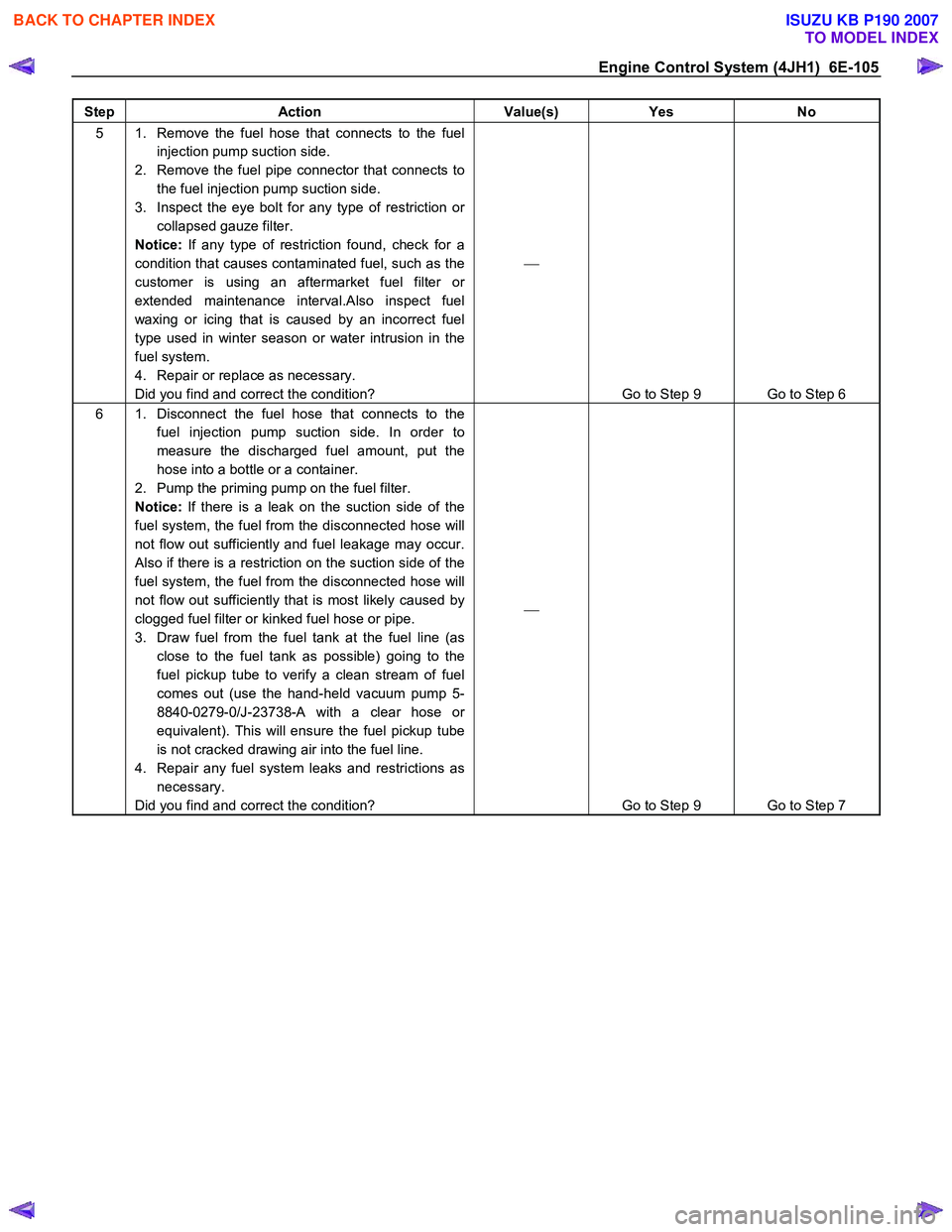
Engine Control System (4JH1) 6E-105
Step Action Value(s) Yes No
5 1. Remove the fuel hose that connects to the fuel
injection pump suction side.
2. Remove the fuel pipe connector that connects to the fuel injection pump suction side.
3. Inspect the eye bolt for any type of restriction or collapsed gauze filter.
Notice: If any type of restriction found, check for a
condition that causes contaminated fuel, such as the
customer is using an aftermarket fuel filter or
extended maintenance interval.Also inspect fuel
waxing or icing that is caused by an incorrect fuel
type used in winter season or water intrusion in the
fuel system.
4. Repair or replace as necessary.
Did you find and correct the condition?
Go to Step 9 Go to Step 6
6 1. Disconnect the fuel hose that connects to the fuel injection pump suction side. In order to
measure the discharged fuel amount, put the
hose into a bottle or a container.
2. Pump the priming pump on the fuel filter.
Notice: If there is a leak on the suction side of the
fuel system, the fuel from the disconnected hose will
not flow out sufficiently and fuel leakage may occur.
Also if there is a restriction on the suction side of the
fuel system, the fuel from the disconnected hose will
not flow out sufficiently that is most likely caused by
clogged fuel filter or kinked fuel hose or pipe.
3. Draw fuel from the fuel tank at the fuel line (as close to the fuel tank as possible) going to the
fuel pickup tube to verify a clean stream of fuel
comes out (use the hand-held vacuum pump 5-
8840-0279-0/J-23738-A with a clear hose or
equivalent). This will ensure the fuel pickup tube
is not cracked drawing air into the fuel line.
4. Repair any fuel system leaks and restrictions as necessary.
Did you find and correct the condition?
Go to Step 9 Go to Step 7
BACK TO CHAPTER INDEX
TO MODEL INDEX
ISUZU KB P190 2007
Page 1140 of 6020
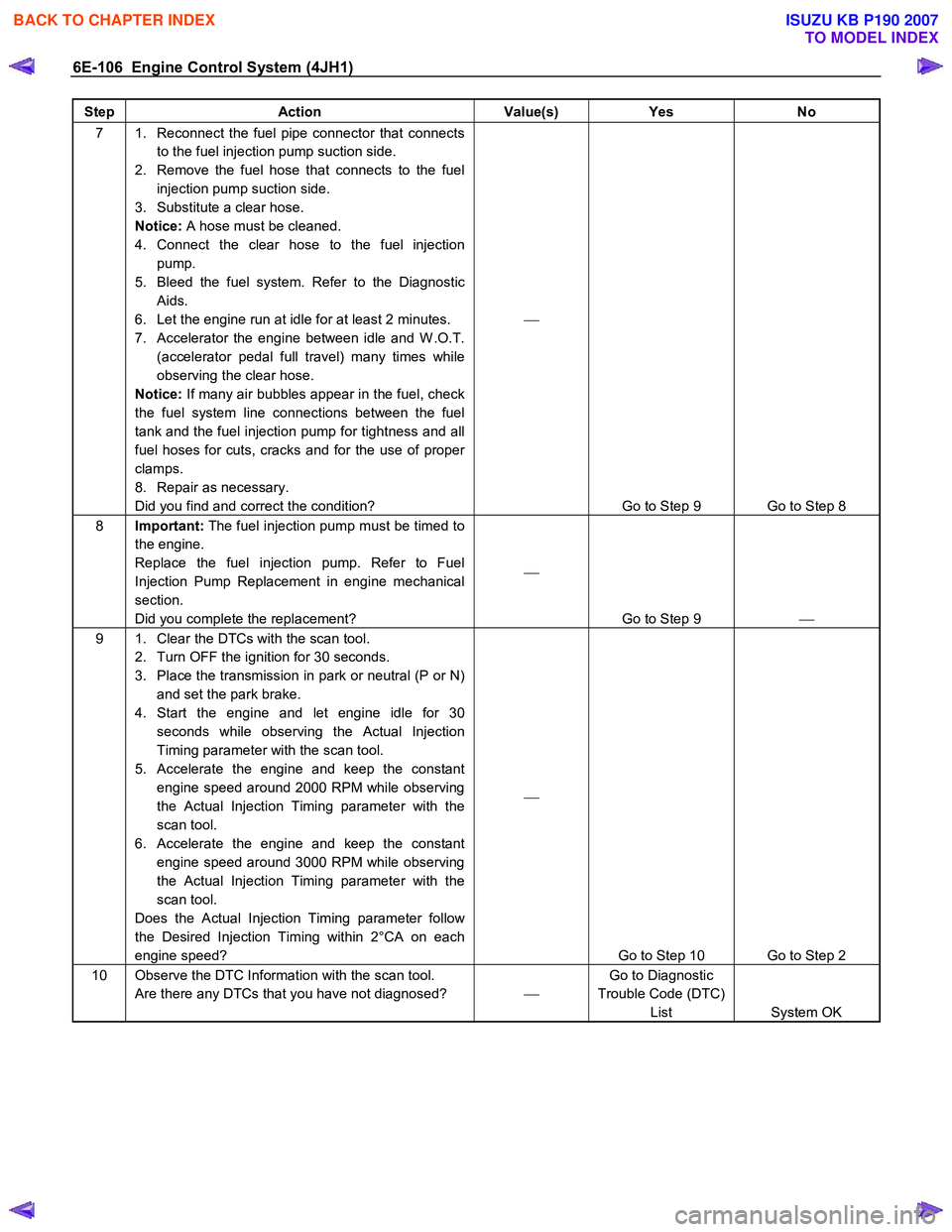
6E-106 Engine Control System (4JH1)
Step Action Value(s) Yes No
7 1. Reconnect the fuel pipe connector that connects
to the fuel injection pump suction side.
2. Remove the fuel hose that connects to the fuel injection pump suction side.
3. Substitute a clear hose.
Notice: A hose must be cleaned.
4. Connect the clear hose to the fuel injection pump.
5. Bleed the fuel system. Refer to the Diagnostic Aids.
6. Let the engine run at idle for at least 2 minutes.
7. Accelerator the engine between idle and W .O.T. (accelerator pedal full travel) many times while
observing the clear hose.
Notice: If many air bubbles appear in the fuel, check
the fuel system line connections between the fuel
tank and the fuel injection pump for tightness and all
fuel hoses for cuts, cracks and for the use of proper
clamps.
8. Repair as necessary.
Did you find and correct the condition?
Go to Step 9 Go to Step 8
8 Important: The fuel injection pump must be timed to
the engine.
Replace the fuel injection pump. Refer to Fuel
Injection Pump Replacement in engine mechanical
section.
Did you complete the replacement?
Go to Step 9
9 1. Clear the DTCs with the scan tool.
2. Turn OFF the ignition for 30 seconds.
3. Place the transmission in park or neutral (P or N) and set the park brake.
4. Start the engine and let engine idle for 30 seconds while observing the Actual Injection
Timing parameter with the scan tool.
5. Accelerate the engine and keep the constant engine speed around 2000 RPM while observing
the Actual Injection Timing parameter with the
scan tool.
6. Accelerate the engine and keep the constant engine speed around 3000 RPM while observing
the Actual Injection Timing parameter with the
scan tool.
Does the Actual Injection Timing parameter follow
the Desired Injection Timing within 2°CA on each
engine speed?
Go to Step 10 Go to Step 2
10 Observe the DTC Information with the scan tool. Are there any DTCs that you have not diagnosed? Go to Diagnostic
Trouble Code (DTC) List System OK
BACK TO CHAPTER INDEX
TO MODEL INDEX
ISUZU KB P190 2007
Page 1141 of 6020
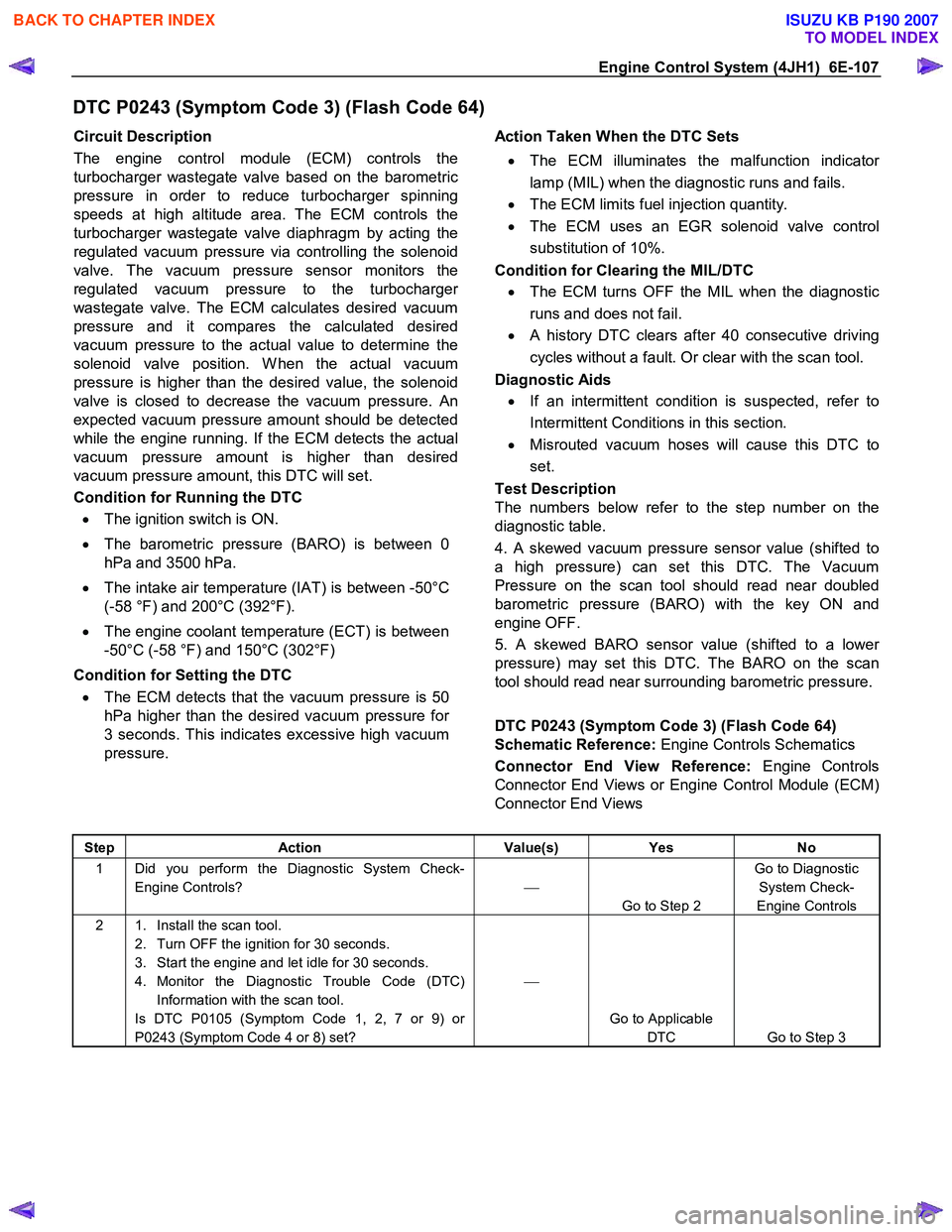
Engine Control System (4JH1) 6E-107
DTC P0243 (Symptom Code 3) (Flash Code 64)
Circuit Description
The engine control module (ECM) controls the
turbocharger wastegate valve based on the barometric
pressure in order to reduce turbocharger spinning
speeds at high altitude area. The ECM controls the
turbocharger wastegate valve diaphragm by acting the
regulated vacuum pressure via controlling the solenoid
valve. The vacuum pressure sensor monitors the
regulated vacuum pressure to the turbocharge
r
wastegate valve. The ECM calculates desired vacuum
pressure and it compares the calculated desired
vacuum pressure to the actual value to determine the
solenoid valve position. W hen the actual vacuum
pressure is higher than the desired value, the solenoid
valve is closed to decrease the vacuum pressure. An
expected vacuum pressure amount should be detected
while the engine running. If the ECM detects the actual
vacuum pressure amount is higher than desired
vacuum pressure amount, this DTC will set.
Condition for Running the DTC
• The ignition switch is ON.
• The barometric pressure (BARO) is between 0
hPa and 3500 hPa.
• The intake air temperature (IAT) is between -50°C
(-58 °F) and 200°C (392°F).
• The engine coolant temperature (ECT) is between
-50°C (-58 °F) and 150°C (302°F)
Condition for Setting the DTC
• The ECM detects that the vacuum pressure is 50
hPa higher than the desired vacuum pressure for
3 seconds. This indicates excessive high vacuum
pressure.
Action Taken When the DTC Sets
• The ECM illuminates the malfunction indicato
r
lamp (MIL) when the diagnostic runs and fails.
• The ECM limits fuel injection quantity.
• The ECM uses an EGR solenoid valve control
substitution of 10%.
Condition for Clearing the MIL/DTC
• The ECM turns OFF the MIL when the diagnostic
runs and does not fail.
• A history DTC clears after 40 consecutive driving
cycles without a fault. Or clear with the scan tool.
Diagnostic Aids
• If an intermittent condition is suspected, refer to
Intermittent Conditions in this section.
• Misrouted vacuum hoses will cause this DTC to
set.
Test Description
The numbers below refer to the step number on the
diagnostic table.
4. A skewed vacuum pressure sensor value (shifted to
a high pressure) can set this DTC. The Vacuum
Pressure on the scan tool should read near doubled
barometric pressure (BARO) with the key ON and
engine OFF.
5. A skewed BARO sensor value (shifted to a lowe
r
pressure) may set this DTC. The BARO on the scan
tool should read near surrounding barometric pressure.
DTC P0243 (Symptom Code 3) (Flash Code 64)
Schematic Reference: Engine Controls Schematics
Connector End View Reference: Engine Controls
Connector End Views or Engine Control Module (ECM)
Connector End Views
Step Action Value(s) Yes No
1 Did you perform the Diagnostic System Check-
Engine Controls?
Go to Step 2 Go to Diagnostic
System Check-
Engine Controls
2 1. Install the scan tool. 2. Turn OFF the ignition for 30 seconds.
3. Start the engine and let idle for 30 seconds.
4. Monitor the Diagnostic Trouble Code (DTC) Information with the scan tool.
Is DTC P0105 (Symptom Code 1, 2, 7 or 9) or
P0243 (Symptom Code 4 or 8) set?
Go to Applicable DTC Go to Step 3
BACK TO CHAPTER INDEX
TO MODEL INDEX
ISUZU KB P190 2007
Page 1145 of 6020
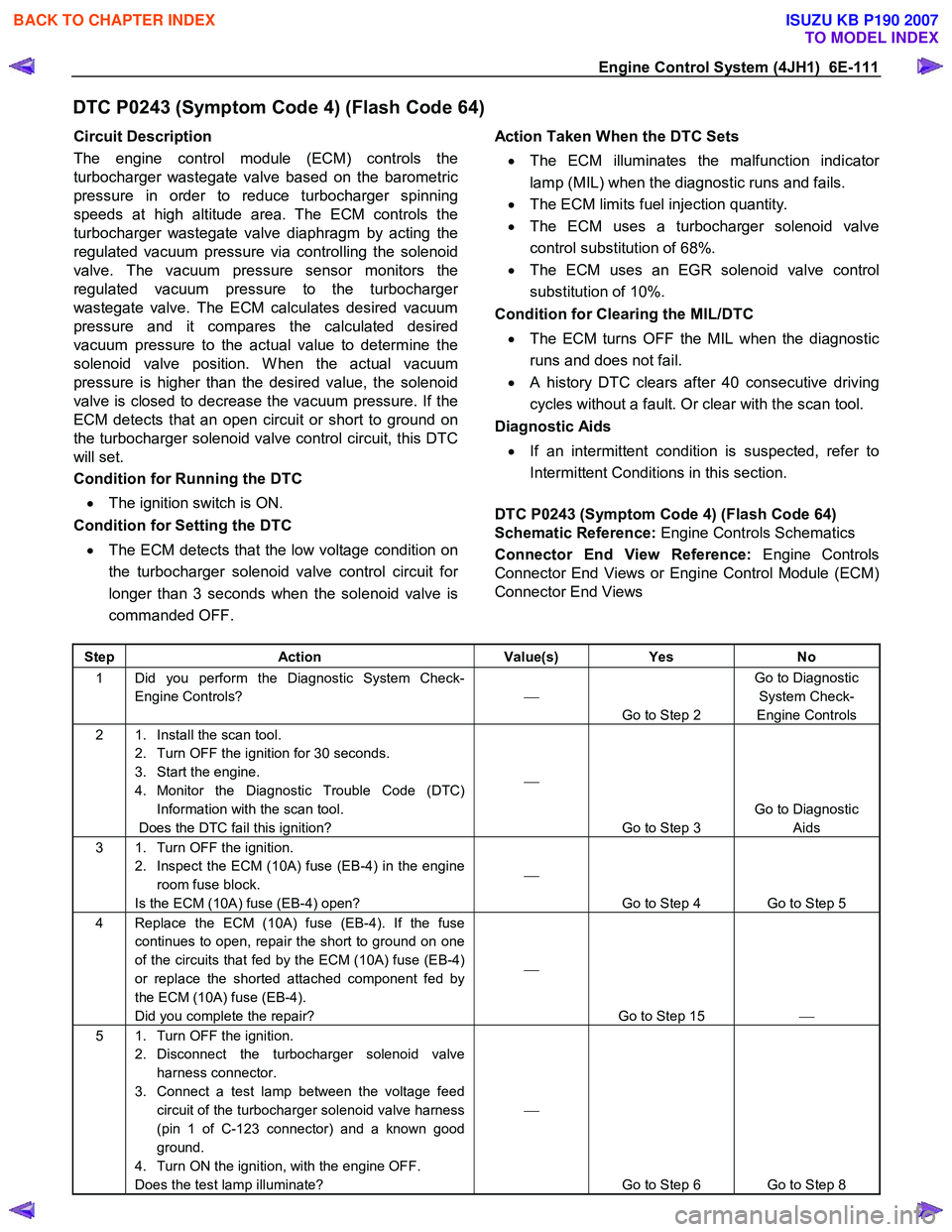
Engine Control System (4JH1) 6E-111
DTC P0243 (Symptom Code 4) (Flash Code 64)
Circuit Description
The engine control module (ECM) controls the
turbocharger wastegate valve based on the barometric
pressure in order to reduce turbocharger spinning
speeds at high altitude area. The ECM controls the
turbocharger wastegate valve diaphragm by acting the
regulated vacuum pressure via controlling the solenoid
valve. The vacuum pressure sensor monitors the
regulated vacuum pressure to the turbocharge
r
wastegate valve. The ECM calculates desired vacuum
pressure and it compares the calculated desired
vacuum pressure to the actual value to determine the
solenoid valve position. W hen the actual vacuum
pressure is higher than the desired value, the solenoid
valve is closed to decrease the vacuum pressure. If the
ECM detects that an open circuit or short to ground on
the turbocharger solenoid valve control circuit, this DTC
will set.
Condition for Running the DTC
• The ignition switch is ON.
Condition for Setting the DTC
• The ECM detects that the low voltage condition on
the turbocharger solenoid valve control circuit fo
r
longer than 3 seconds when the solenoid valve is
commanded OFF.
Action Taken When the DTC Sets
• The ECM illuminates the malfunction indicato
r
lamp (MIL) when the diagnostic runs and fails.
• The ECM limits fuel injection quantity.
• The ECM uses a turbocharger solenoid valve
control substitution of 68%.
• The ECM uses an EGR solenoid valve control
substitution of 10%.
Condition for Clearing the MIL/DTC
• The ECM turns OFF the MIL when the diagnostic
runs and does not fail.
• A history DTC clears after 40 consecutive driving
cycles without a fault. Or clear with the scan tool.
Diagnostic Aids
• If an intermittent condition is suspected, refer to
Intermittent Conditions in this section.
DTC P0243 (Symptom Code 4) (Flash Code 64)
Schematic Reference: Engine Controls Schematics
Connector End View Reference: Engine Controls
Connector End Views or Engine Control Module (ECM)
Connector End Views
Step Action Value(s) Yes No
1 Did you perform the Diagnostic System Check-
Engine Controls?
Go to Step 2 Go to Diagnostic
System Check-
Engine Controls
2 1. Install the scan tool. 2. Turn OFF the ignition for 30 seconds.
3. Start the engine.
4. Monitor the Diagnostic Trouble Code (DTC) Information with the scan tool.
Does the DTC fail this ignition?
Go to Step 3 Go to Diagnostic
Aids
3 1. Turn OFF the ignition. 2. Inspect the ECM (10A) fuse (EB-4) in the engine room fuse block.
Is the ECM (10A) fuse (EB-4) open?
Go to Step 4 Go to Step 5
4 Replace the ECM (10A) fuse (EB-4). If the fuse continues to open, repair the short to ground on one
of the circuits that fed by the ECM (10A) fuse (EB-4)
or replace the shorted attached component fed by
the ECM (10A) fuse (EB-4).
Did you complete the repair?
Go to Step 15
5 1. Turn OFF the ignition.
2. Disconnect the turbocharger solenoid valve harness connector.
3. Connect a test lamp between the voltage feed circuit of the turbocharger solenoid valve harness
(pin 1 of C-123 connector) and a known good
ground.
4. Turn ON the ignition, with the engine OFF.
Does the test lamp illuminate?
Go to Step 6 Go to Step 8
BACK TO CHAPTER INDEX
TO MODEL INDEX
ISUZU KB P190 2007
Page 1148 of 6020
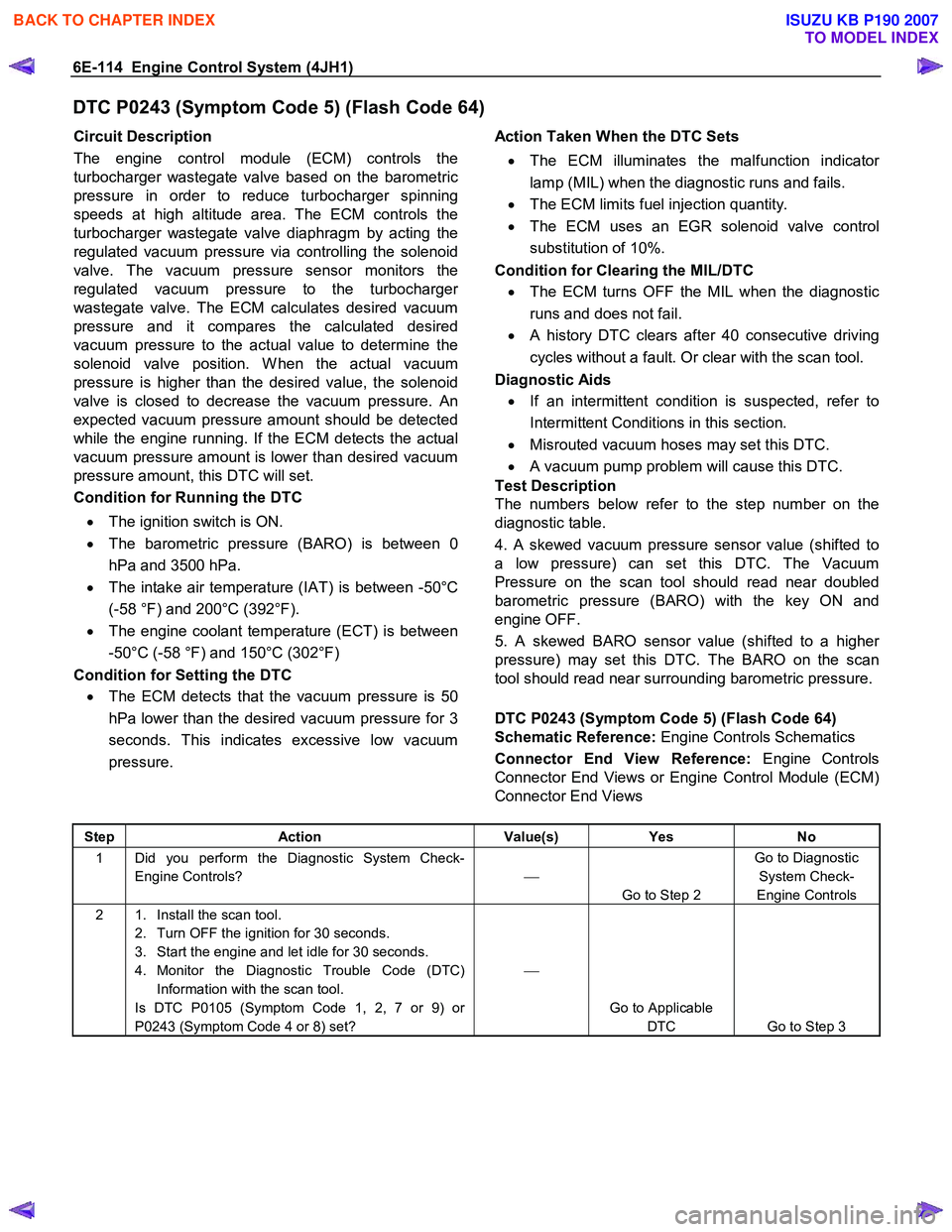
6E-114 Engine Control System (4JH1)
DTC P0243 (Symptom Code 5) (Flash Code 64)
Circuit Description
The engine control module (ECM) controls the
turbocharger wastegate valve based on the barometric
pressure in order to reduce turbocharger spinning
speeds at high altitude area. The ECM controls the
turbocharger wastegate valve diaphragm by acting the
regulated vacuum pressure via controlling the solenoid
valve. The vacuum pressure sensor monitors the
regulated vacuum pressure to the turbocharge
r
wastegate valve. The ECM calculates desired vacuum
pressure and it compares the calculated desired
vacuum pressure to the actual value to determine the
solenoid valve position. W hen the actual vacuum
pressure is higher than the desired value, the solenoid
valve is closed to decrease the vacuum pressure. An
expected vacuum pressure amount should be detected
while the engine running. If the ECM detects the actual
vacuum pressure amount is lower than desired vacuum
pressure amount, this DTC will set.
Condition for Running the DTC
• The ignition switch is ON.
• The barometric pressure (BARO) is between 0
hPa and 3500 hPa.
• The intake air temperature (IAT) is between -50°C
(-58 °F) and 200°C (392°F).
• The engine coolant temperature (ECT) is between
-50°C (-58 °F) and 150°C (302°F)
Condition for Setting the DTC
• The ECM detects that the vacuum pressure is 50
hPa lower than the desired vacuum pressure for 3
seconds. This indicates excessive low vacuum
pressure.
Action Taken When the DTC Sets
• The ECM illuminates the malfunction indicato
r
lamp (MIL) when the diagnostic runs and fails.
• The ECM limits fuel injection quantity.
• The ECM uses an EGR solenoid valve control
substitution of 10%.
Condition for Clearing the MIL/DTC
• The ECM turns OFF the MIL when the diagnostic
runs and does not fail.
• A history DTC clears after 40 consecutive driving
cycles without a fault. Or clear with the scan tool.
Diagnostic Aids
• If an intermittent condition is suspected, refer to
Intermittent Conditions in this section.
• Misrouted vacuum hoses may set this DTC.
• A vacuum pump problem will cause this DTC.
Test Description
The numbers below refer to the step number on the
diagnostic table.
4. A skewed vacuum pressure sensor value (shifted to
a low pressure) can set this DTC. The Vacuum
Pressure on the scan tool should read near doubled
barometric pressure (BARO) with the key ON and
engine OFF.
5. A skewed BARO sensor value (shifted to a highe
r
pressure) may set this DTC. The BARO on the scan
tool should read near surrounding barometric pressure.
DTC P0243 (Symptom Code 5) (Flash Code 64)
Schematic Reference: Engine Controls Schematics
Connector End View Reference: Engine Controls
Connector End Views or Engine Control Module (ECM)
Connector End Views
Step Action Value(s) Yes No
1 Did you perform the Diagnostic System Check-
Engine Controls?
Go to Step 2 Go to Diagnostic
System Check-
Engine Controls
2 1. Install the scan tool. 2. Turn OFF the ignition for 30 seconds.
3. Start the engine and let idle for 30 seconds.
4. Monitor the Diagnostic Trouble Code (DTC) Information with the scan tool.
Is DTC P0105 (Symptom Code 1, 2, 7 or 9) or
P0243 (Symptom Code 4 or 8) set?
Go to Applicable DTC Go to Step 3
BACK TO CHAPTER INDEX
TO MODEL INDEX
ISUZU KB P190 2007
Page 1152 of 6020
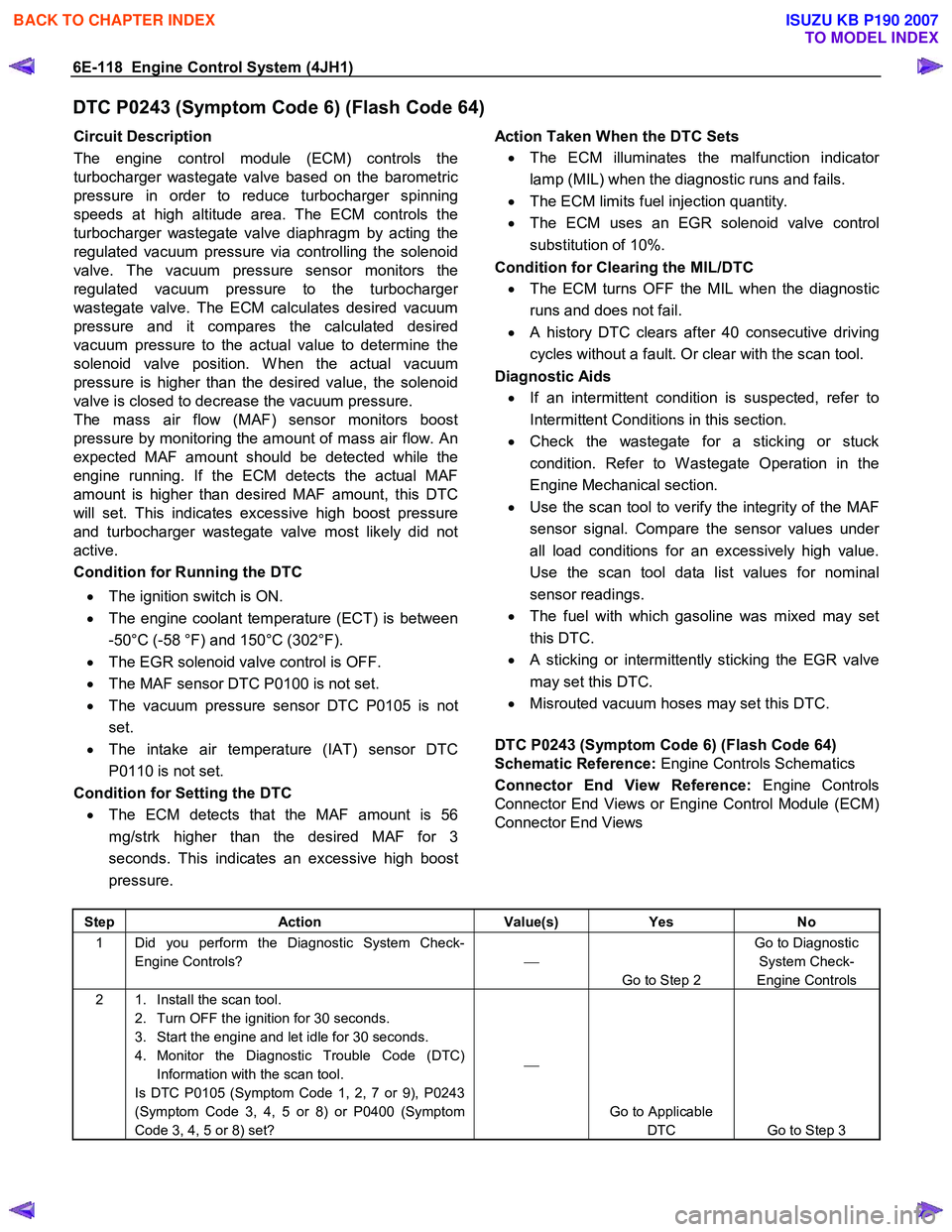
6E-118 Engine Control System (4JH1)
DTC P0243 (Symptom Code 6) (Flash Code 64)
Circuit Description
The engine control module (ECM) controls the
turbocharger wastegate valve based on the barometric
pressure in order to reduce turbocharger spinning
speeds at high altitude area. The ECM controls the
turbocharger wastegate valve diaphragm by acting the
regulated vacuum pressure via controlling the solenoid
valve. The vacuum pressure sensor monitors the
regulated vacuum pressure to the turbocharge
r
wastegate valve. The ECM calculates desired vacuum
pressure and it compares the calculated desired
vacuum pressure to the actual value to determine the
solenoid valve position. W hen the actual vacuum
pressure is higher than the desired value, the solenoid
valve is closed to decrease the vacuum pressure.
The mass air flow (MAF) sensor monitors boost
pressure by monitoring the amount of mass air flow. An
expected MAF amount should be detected while the
engine running. If the ECM detects the actual MAF
amount is higher than desired MAF amount, this DTC
will set. This indicates excessive high boost pressure
and turbocharger wastegate valve most likely did not
active.
Condition for Running the DTC
• The ignition switch is ON.
• The engine coolant temperature (ECT) is between
-50°C (-58 °F) and 150°C (302°F).
• The EGR solenoid valve control is OFF.
• The MAF sensor DTC P0100 is not set.
• The vacuum pressure sensor DTC P0105 is not
set.
• The intake air temperature (IAT) sensor DTC
P0110 is not set.
Condition for Setting the DTC
• The ECM detects that the MAF amount is 56
mg/strk higher than the desired MAF for 3
seconds. This indicates an excessive high boost
pressure.
Action Taken When the DTC Sets
• The ECM illuminates the malfunction indicato
r
lamp (MIL) when the diagnostic runs and fails.
• The ECM limits fuel injection quantity.
• The ECM uses an EGR solenoid valve control
substitution of 10%.
Condition for Clearing the MIL/DTC
• The ECM turns OFF the MIL when the diagnostic
runs and does not fail.
• A history DTC clears after 40 consecutive driving
cycles without a fault. Or clear with the scan tool.
Diagnostic Aids
• If an intermittent condition is suspected, refer to
Intermittent Conditions in this section.
• Check the wastegate for a sticking or stuck
condition. Refer to W astegate Operation in the
Engine Mechanical section.
• Use the scan tool to verify the integrity of the MAF
sensor signal. Compare the sensor values unde
r
all load conditions for an excessively high value.
Use the scan tool data list values for nominal
sensor readings.
• The fuel with which gasoline was mixed may set
this DTC.
• A sticking or intermittently sticking the EGR valve
may set this DTC.
• Misrouted vacuum hoses may set this DTC.
DTC P0243 (Symptom Code 6) (Flash Code 64)
Schematic Reference: Engine Controls Schematics
Connector End View Reference: Engine Controls
Connector End Views or Engine Control Module (ECM)
Connector End Views
Step Action Value(s) Yes No
1 Did you perform the Diagnostic System Check-
Engine Controls?
Go to Step 2 Go to Diagnostic
System Check-
Engine Controls
2 1. Install the scan tool. 2. Turn OFF the ignition for 30 seconds.
3. Start the engine and let idle for 30 seconds.
4. Monitor the Diagnostic Trouble Code (DTC) Information with the scan tool.
Is DTC P0105 (Symptom Code 1, 2, 7 or 9), P0243
(Symptom Code 3, 4, 5 or 8) or P0400 (Symptom
Code 3, 4, 5 or 8) set?
Go to Applicable DTC Go to Step 3
BACK TO CHAPTER INDEX
TO MODEL INDEX
ISUZU KB P190 2007
Page 1155 of 6020
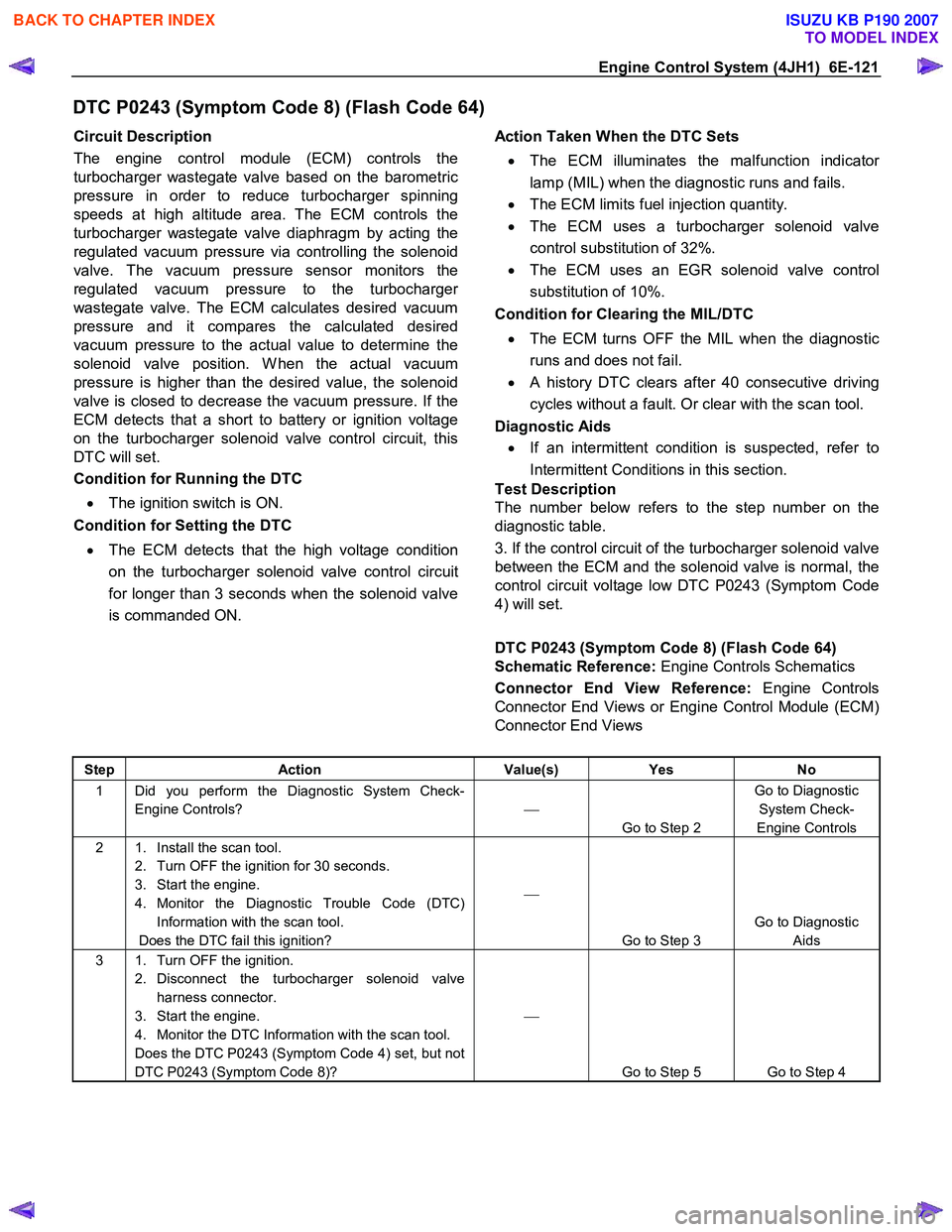
Engine Control System (4JH1) 6E-121
DTC P0243 (Symptom Code 8) (Flash Code 64)
Circuit Description
The engine control module (ECM) controls the
turbocharger wastegate valve based on the barometric
pressure in order to reduce turbocharger spinning
speeds at high altitude area. The ECM controls the
turbocharger wastegate valve diaphragm by acting the
regulated vacuum pressure via controlling the solenoid
valve. The vacuum pressure sensor monitors the
regulated vacuum pressure to the turbocharge
r
wastegate valve. The ECM calculates desired vacuum
pressure and it compares the calculated desired
vacuum pressure to the actual value to determine the
solenoid valve position. W hen the actual vacuum
pressure is higher than the desired value, the solenoid
valve is closed to decrease the vacuum pressure. If the
ECM detects that a short to battery or ignition voltage
on the turbocharger solenoid valve control circuit, this
DTC will set.
Condition for Running the DTC
• The ignition switch is ON.
Condition for Setting the DTC
• The ECM detects that the high voltage condition
on the turbocharger solenoid valve control circuit
for longer than 3 seconds when the solenoid valve
is commanded ON.
Action Taken When the DTC Sets
• The ECM illuminates the malfunction indicato
r
lamp (MIL) when the diagnostic runs and fails.
• The ECM limits fuel injection quantity.
• The ECM uses a turbocharger solenoid valve
control substitution of 32%.
• The ECM uses an EGR solenoid valve control
substitution of 10%.
Condition for Clearing the MIL/DTC
• The ECM turns OFF the MIL when the diagnostic
runs and does not fail.
• A history DTC clears after 40 consecutive driving
cycles without a fault. Or clear with the scan tool.
Diagnostic Aids
• If an intermittent condition is suspected, refer to
Intermittent Conditions in this section.
Test Description
The number below refers to the step number on the
diagnostic table.
3. If the control circuit of the turbocharger solenoid valve
between the ECM and the solenoid valve is normal, the
control circuit voltage low DTC P0243 (Symptom Code
4) will set.
DTC P0243 (Symptom Code 8) (Flash Code 64)
Schematic Reference: Engine Controls Schematics
Connector End View Reference: Engine Controls
Connector End Views or Engine Control Module (ECM)
Connector End Views
Step Action Value(s) Yes No
1 Did you perform the Diagnostic System Check-
Engine Controls?
Go to Step 2 Go to Diagnostic
System Check-
Engine Controls
2 1. Install the scan tool. 2. Turn OFF the ignition for 30 seconds.
3. Start the engine.
4. Monitor the Diagnostic Trouble Code (DTC) Information with the scan tool.
Does the DTC fail this ignition?
Go to Step 3 Go to Diagnostic
Aids
3 1. Turn OFF the ignition. 2. Disconnect the turbocharger solenoid valve harness connector.
3. Start the engine.
4. Monitor the DTC Information with the scan tool.
Does the DTC P0243 (Symptom Code 4) set, but not
DTC P0243 (Symptom Code 8)?
Go to Step 5 Go to Step 4
BACK TO CHAPTER INDEX
TO MODEL INDEX
ISUZU KB P190 2007
Page 1157 of 6020

Engine Control System (4JH1) 6E-123
DTC P0251 (Symptom Code 6) (Flash Code 53)
Circuit Description
The engine control module (ECM) calculates the
desired fuel injection quantity and timing using data sent
from various sensors. These desired data are sent to
the fuel injection pump control unit (PCU) via a
controller area network (CAN) communication bus. The
PCU also receives signals from the internal inputs:
pump camshaft position (CMP) sensor that is located
inside the fuel injection pump to determine the cam ring
rotation angle and the fuel injection pump speed. The
fuel temperature (FT) sensor is internal the PCU. These
values are used to compare the desired values sent
from the ECM then PCU determines the injection time
r
piston position and fuel injection quantity, and actuates
timing control valve (TCV) & fuel injection solenoid
valve based on control maps in the PCU.
The fuel injection solenoid valve is installed to the fuel
injection pump rear side. The fuel injection event is
determined by this solenoid ON/OFF command. The
fuel injection solenoid valve cuts the fuel when the
engine shutoff (ESO) solenoid valve is commanded
shutoff from the PCU. (The fuel injection solenoid valve
and engine shutoff (ESO) solenoid valve is same part. It
calls ESO solenoid valve when fuel is shut off.) W hen
the ignition switch is turned OFF or commanded from
fail-safe action, the ESO solenoid valve is commanded
shutoff to stop the engine running. If the PCU detects
that the fuel injection solenoid valve is operated when
the desired injection quantity from the ECM is 0 mg/strk,
this DTC will set.
Condition for Running the DTC
• The fuel injection pump CMP sensor signal is
generated.
• The CAN communication between the ECM and
PCU is normal.
Condition for Setting the DTC
• The PCU detects that the fuel injection solenoid
valve is operated when the desired fuel injection
quantity is commanded 0 mg/strk.
Action Taken When the DTC Sets
• The ECM illuminates the malfunction indicator
lamp (MIL) when the diagnostic runs and fails.
• The ECM cuts fuel injection.
Condition for Clearing the MIL/DTC
• The ECM turns OFF the MIL when the diagnostic
runs and does not fail.
• A history DTC clears after 40 consecutive driving
cycles without a fault. Or clear with the scan tool.
Diagnostic Aids
• If an intermittent condition is suspected, refer to
Intermittent Conditions in this section.
Notice:
• Fuel injection solenoid valve is internal to the fuel
injection pump assembly.
• PCU is part of the fuel injection pump assembly.
DTC P0251 (Symptom Code 6) (Flash Code 53)
Step Action Value(s) Yes No
1 Did you perform the Diagnostic System Check-
Engine Controls?
Go to Step 2 Go to Diagnostic
System Check-
Engine Controls
2 1. Install the scan tool. 2. Turn OFF the ignition for 30 seconds.
3. Start the engine and let idle for 30 seconds.
4. Accelerate the engine between idle and W .O.T. (accelerator pedal full travel) many times while
observing the Diagnostic Trouble Code (DTC)
Information with the scan tool.
Does the DTC fail this ignition?
Go to Step 3 Go to Step 4
3 Important: The fuel injection pump must be timed to
the engine.
Replace the fuel injection pump. Refer to Fuel
Injection Pump Replacement in engine mechanical
section.
Did you complete the replacement?
Go to Step 4
BACK TO CHAPTER INDEX
TO MODEL INDEX
ISUZU KB P190 2007